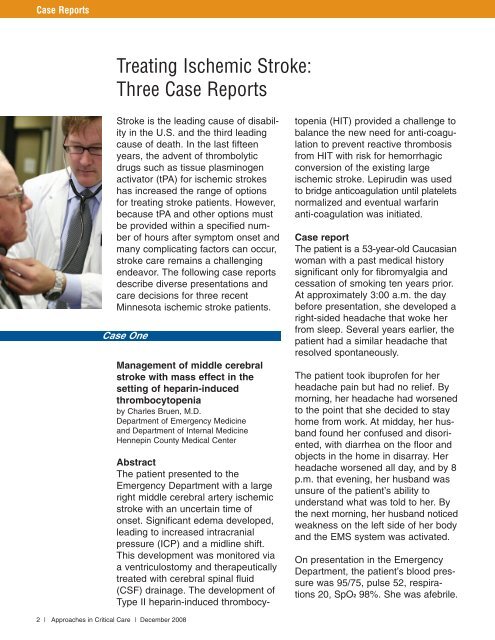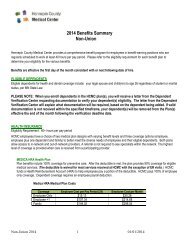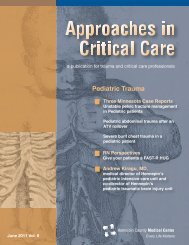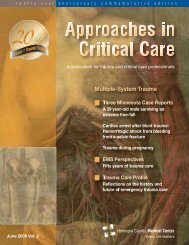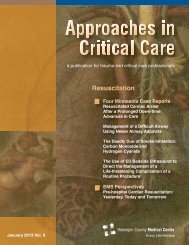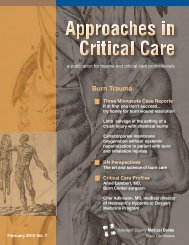Ischemic Stroke - Hennepin County Medical Center
Ischemic Stroke - Hennepin County Medical Center
Ischemic Stroke - Hennepin County Medical Center
Create successful ePaper yourself
Turn your PDF publications into a flip-book with our unique Google optimized e-Paper software.
Case Reports<br />
Treating <strong>Ischemic</strong> <strong>Stroke</strong>:<br />
Three Case Reports<br />
<strong>Stroke</strong> is the leading cause of disability<br />
in the U.S. and the third leading<br />
cause of death. In the last fifteen<br />
years, the advent of thrombolytic<br />
drugs such as tissue plasminogen<br />
activator (tPA) for ischemic strokes<br />
has increased the range of options<br />
for treating stroke patients. However,<br />
because tPA and other options must<br />
be provided within a specified number<br />
of hours after symptom onset and<br />
many complicating factors can occur,<br />
stroke care remains a challenging<br />
endeavor. The following case reports<br />
describe diverse presentations and<br />
care decisions for three recent<br />
Minnesota ischemic stroke patients.<br />
Case One<br />
Management of middle cerebral<br />
stroke with mass effect in the<br />
setting of heparin-induced<br />
thrombocytopenia<br />
by Charles Bruen, M.D.<br />
Department of Emergency Medicine<br />
and Department of Internal Medicine<br />
<strong>Hennepin</strong> <strong>County</strong> <strong>Medical</strong> <strong>Center</strong><br />
Abstract<br />
The patient presented to the<br />
Emergency Department with a large<br />
right middle cerebral artery ischemic<br />
stroke with an uncertain time of<br />
onset. Significant edema developed,<br />
leading to increased intracranial<br />
pressure (ICP) and a midline shift.<br />
This development was monitored via<br />
a ventriculostomy and therapeutically<br />
treated with cerebral spinal fluid<br />
(CSF) drainage. The development of<br />
Type II heparin-induced thrombocytopenia<br />
(HIT) provided a challenge to<br />
balance the new need for anti-coagulation<br />
to prevent reactive thrombosis<br />
from HIT with risk for hemorrhagic<br />
conversion of the existing large<br />
ischemic stroke. Lepirudin was used<br />
to bridge anticoagulation until platelets<br />
normalized and eventual warfarin<br />
anti-coagulation was initiated.<br />
Case report<br />
The patient is a 53-year-old Caucasian<br />
woman with a past medical history<br />
significant only for fibromyalgia and<br />
cessation of smoking ten years prior.<br />
At approximately 3:00 a.m. the day<br />
before presentation, she developed a<br />
right-sided headache that woke her<br />
from sleep. Several years earlier, the<br />
patient had a similar headache that<br />
resolved spontaneously.<br />
The patient took ibuprofen for her<br />
headache pain but had no relief. By<br />
morning, her headache had worsened<br />
to the point that she decided to stay<br />
home from work. At midday, her husband<br />
found her confused and disoriented,<br />
with diarrhea on the floor and<br />
objects in the home in disarray. Her<br />
headache worsened all day, and by 8<br />
p.m. that evening, her husband was<br />
unsure of the patient’s ability to<br />
understand what was told to her. By<br />
the next morning, her husband noticed<br />
weakness on the left side of her body<br />
and the EMS system was activated.<br />
On presentation in the Emergency<br />
Department, the patient’s blood pressure<br />
was 95/75, pulse 52, respirations<br />
20, SpO2 98%. She was afebrile.<br />
2 | Approaches in Critical Care | December 2008


